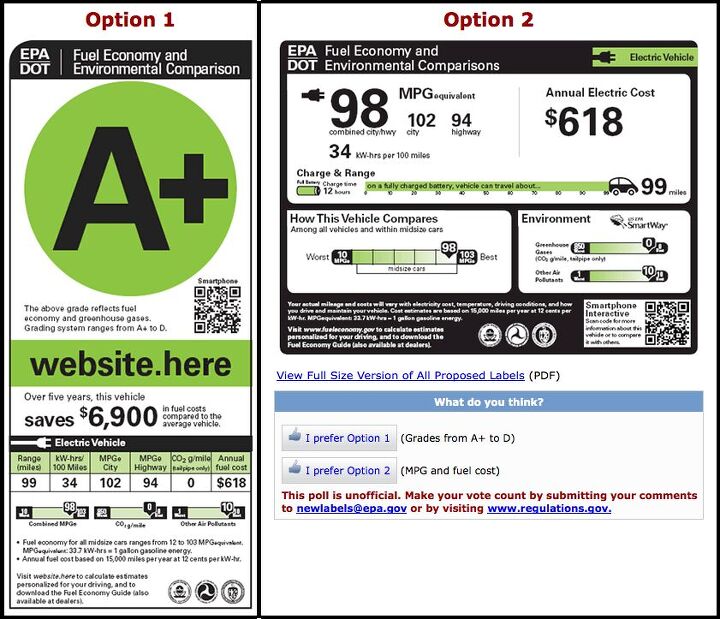Survey Says: Proposed EPA Letter Grades Suck
The recommendations are simple: Scrap the vertical label, lose the letter grade and emphasize the mpg and cost of owning the vehicle. If the EPA takes these steps, it may be successful in increasing the number of fuel-efficient vehicles on the road and communicating clearly with consumers.
Alan Siegel of brand consultants Siegel+Gale summarizes his firm’s independent research on proposed EPA fuel economy label designs in Automotive News [sub]. Siegel interviewed 456 prospective new car buyers, and found that 66 percent preferred the “horizontal” proposal, while 47 percent found the “vertical” style (which includes the letter grade) “confusing.” No word on what percentage found the letter grades to be “asinine.”
The use of the term “MPGe” (miles per gallon equivalent) was also found to be confusing for readers of both labels, but even more so for the vertical label (69 percent misidentified the term on vertical labels, compared to 62 percent on horizontal labels). Siegel’s results have been submitted to the EPA, which is soliciting public comment on the designs. Let us know what you think of the designs, then go vote for yourself at the EPA website. And be sure to use the word “asinine” at least once.
More by Edward Niedermeyer
Latest Car Reviews
Read moreLatest Product Reviews
Read moreRecent Comments
- SCE to AUX This was the same car I had (05 xB, stick, "camouflage" color) for 7 years - great car.We called ours "The Lunchbox". I added aftermarket wheels, and the 3rd-party cruise control the dealers could install.It suffered only two failures: bad window switch in week 2 (dealer fixed in 1 hour), bad trailing O2 sensor (fixed myself for $70). Fuel economy was always 28-34 mpg.It was a potential death trap, and ride quality became unbearable after 2 hours. I once did a 10-hour round trip in it and could barely walk after.Traded it for a 2012 Leaf, which was a better car in some ways.
- Bd2 The "e" nomenclature signifies the e-ATPs which BMW is pursuing.
- Dave M. I'm sorry to see any storied name go away. The lifespan of the Malibu has fit perfectly in my lifetime years-wise. Some of the highlights include the first and second generations, the '78 revamp (very clean design), and the 2005 generation. Ford, GM and Mopar gave this segment away by allowing Toyota and Honda a foot in the door and then always having to play catch-up. How hard is it to make a truly competitive sedan at a profit? Obviously, Japan Inc. figured it out.I've driven a few rentals these past years; the Malibu got the job done but honestly the Passat and Altima were my rental preferences.
- Kcflyer actually yes. It's a shame that a product this uncompetitive can still outsell GM's entire EV offerings. Those products have had billions thrown at them. Imagine how nice the new Malibu, Impala, SS, and Lacrosse would be with that kind of commitment.
- 3SpeedAutomatic Nope....





































Comments
Join the conversation
Be prepared to see a Federal tax on autos, especially if cap and trade is watered down. Having four grades (actually five if you count A+) makes it easier for the public comprehend the penalty they have to pay. I have yet to see the methodology behind assigning grades and I suspect overseas manufacturers will find themselves in a more expensive category. Call it a hidden tariff.
Uhhh- I'm so tired of dumbed-down measurements. This is especially bad because as soon as a vehicle is rated "A", there is no room to ever indicate any vehicle is better than that one. If they're going to do this, they could at least quantify, say, the amount of energy required to build, maintain, and operate the vehicle, and tell you what percentile that falls in for that model year. I'm also tired of superlative definitions that are meaningless, such as "Low Emissions Vehicle", Super Low, Ultra Low, Partial Zero etc. It's impossible to tell which is better than the other, and why. And WTF does "partial zero" mean. Zero can't be divided into parts! (What it really means is that it is zero emissions while it's turned off. No kidding). Even Zero Emissions Vehicles aren't quite zero emissions, since electric motors emit a little ozone. For that matter, even mpg is a misleading term- especially when mpg numbers get high. Peoples conception of mpg is often that an x-mpg improvement saves the same amount of gas, no matter where it is. E.g. going from 15 mpg to 30 mpg saves the same amount of fuel as going from 30 to 45. In fact, to save as much gas per year as going from 15 to 30 mpg, you'd have to go from 30 to infinity. This means the people upgrading from their 36 mpg civic to their 48 mpg Prius are saving very little fuel, despite the 12 mpg improvement, while someone going from 20 to 32 mpg is going to save much MUCH more fuel. If mpg was replaced with gallons/100mi, similar to what they do in Europe and everywhere else, this would be apparant. This is where it DOES make sense to have a maximum possible score- the limit approaching 0. The dollars per year comes close to this measure, but it depends on how much fuel costs when the label was printed, the difference in fuel price between where you live and the national average, and how much you drive. If they just gave us gallons/100mi, it would be MUCH more useful. As an aside, using gallons per 100 miles is much more useful in illustraing how accessories, like AC or a bike rack, affects efficiency. For instance, a big bike rack on your hummer may reduce mileage from 12 mpg (19.6 liter per 100km) to 11 mpg (21.4 l/100km). The same rack on a gen-1 Honda insight may reduce mpg from 70 mpg (3.4 l/100km) to 45 mpg (5.2 l/100km). Using MPG, the hummer owner would say the rack makes almost no difference, while the Insight owner would say it totally destroyed his mileage. Using l/100km, you can see that the rack requires EXACTLY the same amount of additional fuel on either vehicle- an extra 1.8 l/100km). People do the same thing with AC for instance- barely noticing it on a big car, and noticing a big difference in mpg in a small car, when in reality the difference won't be that big.